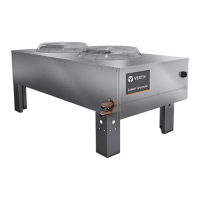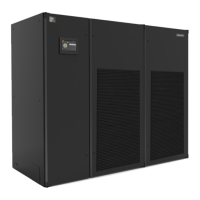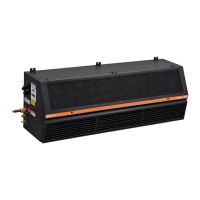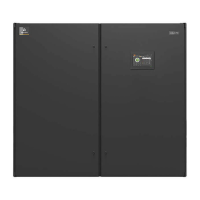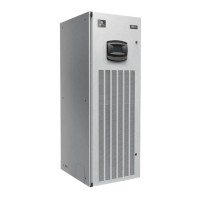
Do you have a question about the Vertiv Liebert LPC Series and is the answer not in the manual?
| Refrigerant | R410A |
|---|---|
| Compressor Type | Scroll |
| Airflow Configuration | Upflow, Downflow |
| Power Input | 208/230V, 460V |
| Operating Temperature Range | 0°C to 45°C |
| Humidity Range | 20% to 80% RH |
| Airflow | Varies by model |
| Dimensions (HxWxD) | Varies by model |
| Weight | Varies by model |
| Noise Level | Varies by model |
Provides an overview of the primary and optional components within the Liebert LPC series of air conditioners.
Describes the DC Inverter Scroll compressor, its features, efficiency, and reliability in various conditions.
Covers preliminary steps before installation, including transportation, unpacking, and inspection of the unit.
Focuses on preparing the installation environment, including equipment room and space requirements for optimal operation.
Specifies requirements for the equipment room, such as heat insulation, damp-proofing, and ventilation for smooth operation.
Covers key aspects of mechanical installation, including preparation checks, unit placement, and securing methods.
Explains the system installation schema, including condenser positioning relative to the compressor.
Guides on creating and installing the base for the indoor unit, ensuring structural stability and proper alignment.
Provides steps for determining installation position, fixing the base, and ensuring it is leveled for unit placement.
Outlines the four types of pipes to be installed, including drain, water inlet, copper, and optional extension kits.
Provides specifications for determining pipe diameters based on system pressure drop and piping length.
Details the process of charging refrigerant and adding refrigerant oil, including standard amounts and refill calculations.
Provides a checklist to ensure all mechanical installation points are verified and compliant before proceeding.
Covers the overall process of electrical installation, including wiring, regulations, and safety precautions.
Explains the systematic wiring procedures for the indoor unit, covering power and control connections.
Details how to connect the power cable to the indoor unit's power connectors, adhering to wiring regulations.
Provides a checklist for verifying the correct configuration and safety of electrical installations before operation.
A comprehensive checklist covering all pre-commissioning steps for the Liebert LPC model to ensure readiness.
Details the process of adding refrigerant, including packing, vacuuming, and using service tools for evacuation mode.
Guides on evacuating nitrogen gas and achieving a specific pressure before charging refrigerant for proper operation.
Describes accessing background service tooling and operating in manual control mode for evacuation and system checks.
Explains the importance and procedure for adding POE refrigeration oil, its impact on lubrication, and quantities.
Guides on calculating the required refrigerant charge based on system configuration, piping length, and outdoor temperature.
Provides methods for troubleshooting LPC unit operations using computer monitoring and control features for diagnostics.
Details establishing a connection to the LPC units via service tooling, selecting communication parameters in the software.
Offers guidance on using key service software functions for device detection, refrigerant charge quantification, and start-up procedures.
Outlines the detailed steps for commissioning the unit, including checking power, detecting components, and filling.
Guides on checking the power supply to each component, ensuring correct cable connections and absence of alarm phases.
Describes the process of rapidly charging refrigerant into the system, managing high and low pressure gauges for optimal fill.
Provides methods to prevent compressor damage during start-up by managing liquid refrigerant flooding through specific filling techniques.
Outlines post-commissioning checks, including parameter verification, leak checks, and submission of commissioning reports.
Provides a procedure for setting parameters within sub-menus using the controller's navigation keys and confirmation steps.
Details the Alarm menu and its sub-menus (Status, History, Setup, Process) for managing and monitoring system alarms.
Describes the Alarm Status function used to record and display active alarm statuses, including serial numbers and times.
Explains how to query the history of alarm records, including active alarms, serial numbers, and time stamps.
Details the Alarm Setup function, which allows defining set points for system configurations like temperature and humidity alarms.
Details checks for ensuring electrical connections are correctly configured, including insulation tests and terminal fastening.




